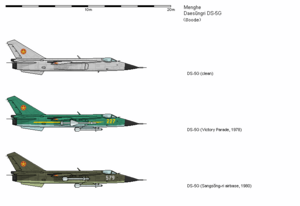Daesŭngri Aircraft Corporation
 Revised logo adopted in 2004 | |
| State-owned | |
| Industry | Defense |
| Predecessor | Daesŭngri Aviation Design Bureau |
| Founded | April 8, 1965 in Daedong, Girim, Menghe |
| Founder | Gang Sŏk-wŏn |
| Headquarters | , |
Number of employees | 17,000 (2019) |
Daesŭngri Aircraft Corporation (Menghean: 대승리 항공기 공업 / 大勝利航空機工業, Daesŭngri Hanggonggi Gongŏb), formerly known as the Daesŭngri Aircraft Design Bureau, is a Menghean state-owned enterprise specializing in the design and manufacture of military aircraft. It is headquartered in Donggyŏng, Menghe's capital, but its main production facility is in Daedong, a city of 1.02 million people located in Girim Province.
Daesŭngri is one of Menghe's two largest military aircraft suppliers, the other being Songrim. Historically it focused on fighter aircraft, though in recent years it expanded into trainer aircraft and unmanned aerial vehicles. In contrast to the heavier combat aircraft produced by Songrim, Daesŭngri designs tend to emphasize agility and low-level performance.
History
Prior to the end of the Menghean War of Liberation, the Menghean Communist government in the North was already beginning work on an aircraft factory in Daedong, where it would manufacture Letnian MiG-17 fighter aircraft. This factory was opened in March 1965 as the "No. 112 Aircraft Factory Named in Honor of the Menghean People's Great Victory," a name which was quickly shortened to "Great Victory," or Daesŭngri. Though its initial work consisted of assembling knock-down kits exported from Letnia via Polvokia, the factory soon began independent work on improving the MiG-17, and in 1967 it was formally reorganized as a design bureau under the Ministry of National Defense.
The factory's production manager, later Daesŭngri's lead designer, was Gang Sŏk-wŏn, a fighter ace who had scored 21 victories flying a Chikai Type 40 fighter in the Pan-Septentrion War. Based on his wartime experience, and the experience of pilots flying with the Menghean Liberation Army, Gang emphasized the importance of agility and maneuverability in aerial combat, blaming the MiG-17's lackluster turning performance and poor cockpit visibility for Menghe's unfavorable kill-to-loss ratio in the War of Liberation.
On this basis, Daesŭngri declined to procure the new MiG-21, instead licensing its more agile swept-wing Ye-2A prototype as the DS-2. With the help of like-minded officers in the Menghean People's Army, Gang's "guerilla air combat theory" grew into a coherent design philosophy which stressed the following principles:
- Air-to-air missiles remain unreliable, and most air-to-air combat will be performed at close distances and low altitudes.
- The most important characteristics of a fighter are its turning circle, its cockpit visibility, and its thrust-to-weight ratio. Weight should be minimized wherever possible.
- Multirole combat aircraft make too many tradeoffs and are inferior to dedicated fighters.
- Close air support is more important than air interdiction.
- Given Menghe's economic constraints, aircraft should be cheap, simple, and easy to maintain.
- Aircraft should be rugged enough to conduct short landings and operate from dirt airstrips.
The design team's first opportunity to put these principles to the test came in 1971, when Sim Jin-hwan invited the bureau to submit designs for a new jet fighter. The resulting Daesŭngri DS-5, Menghe's first domestic jet fighter, made its maiden flight on July 12th, 1974. Though it did incorporate an air-search radar, it also featured redundant twin engines, variable-sweep wings, twin 23mm guns, and better agility than the Letnian MiG-23 against which it competed.
In 1999, the Daesŭngri Aviation Design Bureau was formally reorganized as the Daesŭngri Aircraft Corporation, a state-owned enterprise with a national defense mandate. Its updated design philosophy can be seen in the DS-9 fighter, which combines agility, simplicity, and ruggedness with multirole capability and a state-of-the-art radar, resulting in a lightweight counterpart to the Songrim SR-8.
Since the debut of the DS-9, Daesŭngri has had relatively little success in putting out new designs, stirring speculation that its design team is beset with financial troubles and conflicts over philosophy. Since the mid-2000s, the company was said to be working on a low-observable stealth fighter, but by 2017 there was still no news of a working prototype, and the scale models unveiled at airshows met with skepticism from aviation experts. In early 2018, rumors circulated online that a prototype had crashed at the Hŭksan Proving Ground, killing the pilot; no official government statement on the issue has been released. Large orders for the DS-11 trainer and continuing work on the DS-9 fighter have thus far kept Daesŭngri afloat, and the company's unmanned aircaft division has produced some lightweight reconnaissance drones for front-line units, but Songrim appears poised to win the MoND's 5th-generation fighter contract with its SR-12 design.
Organization
Daesŭngri is currently organized as a state-owned corporation with a national-defense designation, meaning that it is financially separate from the national government but does not face a free-market profit mandate.
In 2003, Daesŭngri acquired Gokchŏn AeroEngine, formerly the Gokchŏn Jet Engine Design Institute. Gokchŏn turbojets power the DS-11 trainer, and are believed to power the DS-13 stealth fighter design. They have also appeared on some UAV and cruise missile designs.
- Daesŭngri Aircraft Corporation
- Daesŭngri Military Aircraft Design Center
- Daesŭngri Aircraft Production Group
- Daedong No. 112 Aircraft Factory
- Yŏngjŏng Airframe Plant
- Gokchŏn AeroEngine Corporation
Products
Fighters
- Daesŭngri DS-2
- Daesŭngri DS-5
- Daesŭngri DS-9
- Daesŭngri DS-13 (planned)
Lead-in trainers
Unmanned aerial vehicles
- Daesŭngri MI-20
- Daesŭngri MI-45
